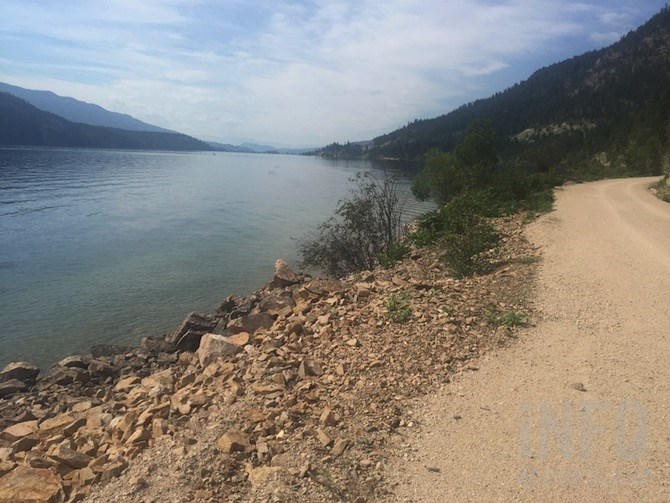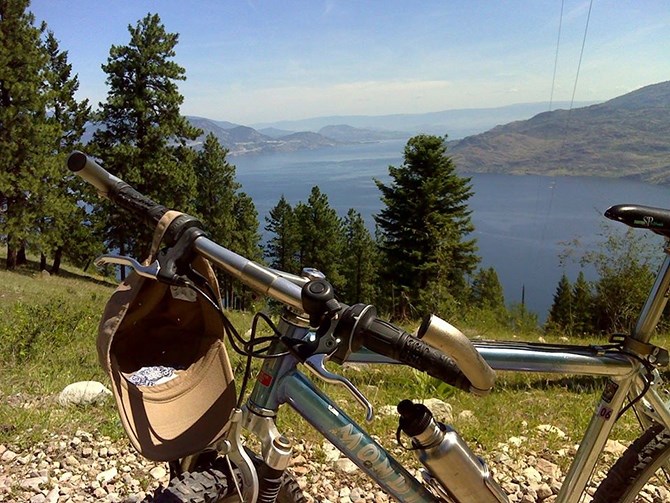
Cyclists on the Okanagan Rail Trail.
(BEN BULMER / iNFOnews.ca)
February 05, 2021 - 7:30 AM
If anyone wants to learn about the economic benefits of an Okanagan Rail Trail, they need look no further than Cory Holland.
He’s the owner of the Oyama General Store who, a few years ago, just couldn’t get his head around the fact that people would want to walk and cycle on the old CN rail line that was ripped out next to his store in 2014.
“I’ve never been so wrong about anything in my life,” he told iNFOnews.ca
His story is one that should resonate with many in the South and Central Okanagan where a future rail trail is the furthest away from reality of any of the three major links needed to connect Sicamous to Osoyoos and beyond.
And it’s an example of why the Trail of the Okanagans Society is trying to get an economic impact study done to help drive the effort in the South Okanagan.
Holland bought the store in 2003 and weathered the storm of Highway 97 being rerouted up the hill above Wood and Kalamalka lakes in 2013. In fact, at that time, he argued that would be good for the community as a whole since traffic just roared by all day anyways.
But it loved the railway.
“The train would actually stop for coffee here,” Holland said. “It was really cool. They took my kids for a little ride on the train over the isthmus.
“So, when they were going to pull the railway out and turn it into a trail, it sounded OK but, at the same time I thought: This is crazy. I don’t get it. Why would people walk on it?
“Even though I own this little store in a touristy area, I wasn’t seeing the big picture. I had people telling me left and right, oh, this rail trail is going to be the best thing that ever happened. I’m a pretty optimistic guy and I just didn’t see it happening. There was no way it was going to be as positive as everybody and his dog was telling me.”
The trail opened officially on Sept. 27, 2018 and the users flooded in. Holland even opened up SoKal Board and Bike rentals to rent bikes to trail users. He now calls Oyama the “Hub of the Rail Trail.”
An economic impact study for the Rail Trail predicted 500,000 annual users after five years but that was achieved in the first year and likely significantly surpassed that number in 2020 as COVID-19 drove people outdoors, Matt Vader, who heads the local government committee overseeing the trail, said.
Holland’s business has benefited greatly from having a busy summer season to being busy from March through the fall.

A stretch of the Okanagan Rail Trail along Kalamalka Lake.
(ROB MUNRO / iNFOnews.ca)
Being on the isthmus between Wood and Kalamalka lakes, it’s arguably the most scenic part of the trail and at one end, the loop trails around Wood Lake using the Rail Trail or Pelmewash Drive (the old Highway 97).
But there’s limited development potential there because everything has to be on septic systems.
At the other end of the lake, the connection from Pelmewash Drive to commercially zoned lands on Woodsdale Road is not very good at this time. Vader is hoping that will be changed next year, which might encourage more businesses to take advantage of being close to the Rail Trail.
But, for a rail trial to draw tourists from outside the region, it needs to be much longer than the existing Okanagan Rail Trail.
READ MORE: We are so close to a rail trail connecting Osoyoos to Sicamous
That’s only 50 km long and not yet finished because of a section along Duck Lake from Kelowna Airport to Lake Country that is still waiting for the federal government to transfer some of that missing piece to the Okanagan Indian Band. That was expected to happen more than a year ago.
“If you really want to have a trail that will bring tourists in from a region beyond your own, the trail has to have a number of things,” Janice Liebe, president of Trail of the Okanagans Society, said. “It has to have a certain length. What cycle tourists are looking for are trails that are long enough that allow them to cycle anywhere from four to seven days and they like to cycle somewhere in the range of 50 to 80 km per day. That tells you that you need to be somewhere in the range of, 250 to 350 km long to make that worthwhile for somebody to make a trip.
“The Okanagan Rail Trail, on its own, isn’t long enough. But, if we connect all the way from Sicamous down to Osoyoos, that’s 250 km and that puts us well in the range of what a cycle tourist is looking for. So, in addition to your local residents who are looking to recreate and commute, now you’ve brought in an entire different sector of people.”

A section of the North Okanagan-Shuswap Rail Trail.
Image Credit: Regional District of North Okanagan
To the north, the Shuswap Trail Alliance has secured 50 km of rail line from Sicamous to Armstrong. All that’s needed now is the money to build the trail. Fundraising efforts have started and there is hope that a two-kilometre demonstration trail in Enderby will be open later this year.
READ MORE: Work on first stage of Sicamous to Armstrong rail trail to start this year
That means a trail of more than 100 km from Sicamous to Kelowna is a distinct possibility in the foreseeable future since almost all the land is secured in public hands.
That’s not the case for the southern section.
Part of the problem is that there was never any rail line between Kelowna and Penticton since the CN line ended in Kelowna.
The Kettle Valley Railway is high in the hills south of Kelowna and never had a direct connection to that city.
That leaves trail advocates trying to find a route from the Bennett bridge in West Kelowna to Summerland. There are useable sections there but many challenges remain.

The Trail of the Okanagans Society is trying to make the trail from the Bennett Bridge to Osoyoos a reality.
Image Credit: SUBMITTED
READ MORE: Filling the gaps: Efforts ramping up to complete cycling trail from Sicamous to Osoyoos
The KVR does run from Summerland to Penticton but part of it goes through Penticton Indian Band lands. When that rail line was discontinued years ago the land was supposed to revert to the Band.
That still hasn’t happened. Like the Okanagan Indian Band at Duck Lake, the federal government has to cede the land to the bands before they can decide whether to open connect it to their respective rail trials.
Much of the focus of the Trail of the Okanagans falls within the Regional District of Okanagan Similkameen and they don’t necessarily agree on the best route for the trail to take.
There is a connection from Penticton to Okanagan Falls but the KVR was sold off there and city streets are the only route through.
The regional district has secured a right-of-way along Cedar Avenue and the Trails group points to the fact that its an existing route that’s quite safe, but they diverge at the south end of the community.
Liebe points out that people are already crossing the highway and cycling down the dike along the Okanagan River.
Mark Woods, general manager of community services for the regional district, says that’s a notoriously dangerous crossing point and he advocates a different route with a safer crossing further south.
Key to any connection to Osoyoos is the Vaseux Lake bottleneck with a steep cliff next to Highway 97 on the east side and the KVR running through an environmentally sensitive area on the west side that, while people do use it, is not supported as a trail by senior governments.
READ MORE: Regional board challenges environmental study conclusion on trail location around Vaseux Lake
The regional district did write a Regional Trails Master Plan in 2011 that involved 22 organizations on its steering committee. But that covers the entire regional district and involves motorized and other users.
Based on that plan, the regional district has acquired rights of way and tenure leases to as much of the old KVR line as it can, since much of it is owned by the province.
It upgrades and maintains what it can but has a limited budget, Woods said.
Some of what it has been able to obtain is not accessible to users. An example Woods gave was an eight kilometre stretch south of Vaseux Lake that has no access points at either end so it isn’t practical, at this time, to build a trail.
There are others sections, such as through Okanagan Falls and into Osoyoos, that were sold off years ago and are either privately owned or used as streets.
Along one section, the regional district chose to put the trail on the Okanagan River dike because farmers were using the old KVR.
While bike routes have been developed in some areas, it has taken years to get permission from the Ministry of Transportation for things like directional signs through Osoyoos, Woods said.
A consultant has been hired to update the trails plan this year and Woods hopes to have an equally broad representation on the steering committee as there was in 2011.
That is likely to provide an opportunity for all the rail trail stakeholders to come together and agree to a strategy to make it a reality.
Which also ties into the Trail of the Okanagans efforts to do an economic impact study.
“We’re going to need a collective approach between all of the stakeholders along that route,” Liebe said. “One of the ways to do that is to demonstrate the positive economic impact that can take place when you bring trails like this into being.”
Which gets back to Holland at the Oyama General Store who, initially was not seeing the big picture of what a rail trail could bring to a community.
“The amount of people that use it, – it’s amazing,” he said. “It’s not just great for business. My kid is in elementary school here. It’s pretty heartwarming. I can see his class coming down the Rail Trail. They come down and do something on the beach or head over to the park. Our family uses it all the time.”
To contact a reporter for this story, email Rob Munro or call 250-808-0143 or email the editor. You can also submit photos, videos or news tips to the newsroom and be entered to win a monthly prize draw.
We welcome your comments and opinions on our stories but play nice. We won't censor or delete comments unless they contain off-topic statements or links, unnecessary vulgarity, false facts, spam or obviously fake profiles. If you have any concerns about what you see in comments, email the editor in the link above.
News from © iNFOnews, 2021